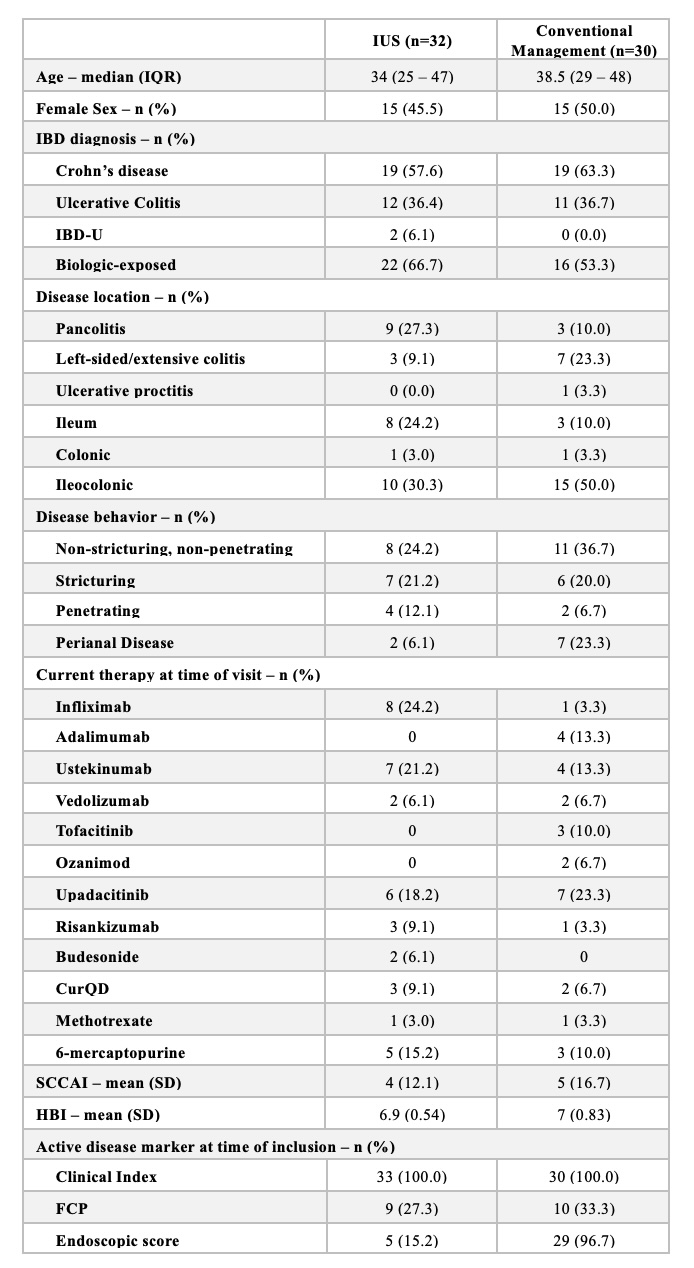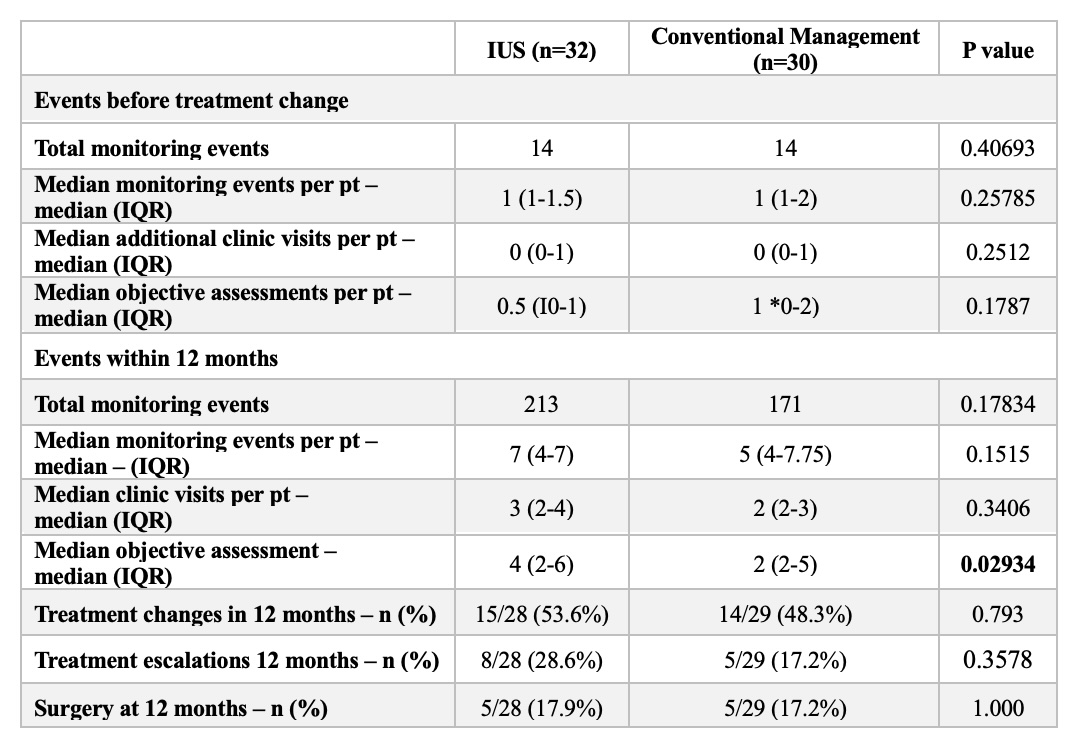Sunday Poster Session
Category: IBD
P1102 - Management by Intestinal Ultrasound Compared to Conventional Management Is Associated With Increased Objective Monitoring Frequency in Patients With Active Inflammatory Bowel Disease
Sunday, October 26, 2025
3:30 PM - 7:00 PM PDT
Location: Exhibit Hall

Noa Krugliak Cleveland, MD (she/her/hers)
University of Chicago
Chicago, IL
Presenting Author(s)
Noa Krugliak Cleveland, MD1, Charlotte M. Duty, BA2, Khushi S. Bhondwe, BS2, Emma A. Picker, 1, Natalie K. Choi, BS1, David T. Rubin, MD3
1University of Chicago, Chicago, IL; 2University of Chicago Medicine, Chicago, IL; 3University of Chicago Medicine Inflammatory Bowel Disease Center, Chicago, IL, USA, Chicago, IL
Introduction: Intestinal ultrasound (IUS) is a non-invasive and accurate tool to monitor disease activity in patients (pts) with inflammatory bowel disease (IBD). We previously demonstrated that management by IUS compared to conventional management is associated with shorter time to achieving clinical remission (128 vs 230 days, p=0.04). In order to understand the variables influencing our prior findings, in this study we assessed whether IUS management is associated with more enhanced monitoring, treatment adjustments, or surgical interventions compared to conventional management (CM).
Methods: We previously performed a retrospective analysis of pts with IBD seen between October 2021-October 2023 who were managed by IUS or CM, matched by provider and disease type and phenotype. At index inclusion pts were required to have active clinical disease (Simple Clinical Colitis Activity Index >2 or Harvey-Bradshaw Index >4), and a subsequent treatment change. In this analysis of the cohort, we assessed for the number of monitoring events (clinic visit, bowel imaging by CT, MR or IUS, endoscopy, or fecal calprotectin (FCP)), number of treatment changes, and surgical intervention over 12 months. Pts could be included twice if they relapsed after 12 months of follow up. Standard t-test, Fisher’s exact test, and Mann-Whitney U tests were used.
Results: 54 pts were included with a total of 62 index encounters (32=IUS, 30=CM), managed by 3 different providers (Table 1). For the IUS and CM cohorts respectively: median number of monitoring events per pt was 7 (IQR 4-7) vs 5 (IQR 4-7.75), (p=0.1515); the median number of clinic visits was 3 (IQR 2-4) vs 2 (2-3), (p=0.3406); the median number of objective monitoring was 4 (IQR 2-6) vs 2 (IQR 2-5), (p=0.02934); the number of pts who had an additional treatment change within 12 months was 15/28 (53.6%) vs 14/29 (48.3%), (p=0.793); the number of pts who underwent surgery within 12 months was 5/28 (11.1%) vs 5/29 (21.7%), (p=1.0).
Discussion: Management by IUS compared to CM is associated with increased number of objective monitoring events, but not more clinic visits, treatment changes, or surgeries; this suggests improved remission rates may be due to tighter objective disease monitoring.

Figure: Table 1. Patient Demographics and Disease Characteristics

Figure: Table 2. Patient Outcomes
Disclosures:
Noa Krugliak Cleveland: Johnson & Johnson – Consultant. NueroLogica – Consultant.
Charlotte Duty indicated no relevant financial relationships.
Khushi Bhondwe indicated no relevant financial relationships.
Emma Picker indicated no relevant financial relationships.
Natalie Choi indicated no relevant financial relationships.
David Rubin: AbbVie – Advisory Committee/Board Member, Consultant, Speaker fees. Abivax SA – Consultant. Altrubio – Advisory Committee/Board Member, Consultant, Speaker feees, Stock Options. Avalo – Advisory Committee/Board Member, Consultant, Speaker fees. Bausch Health – Consultant. Bristol Myers Squibb – Advisory Committee/Board Member, Consultant, Speaker fees. Buhlmann Diagnostics – Advisory Committee/Board Member, Consultant, Speaker fees. Celltrion – Consultant. ClostraBio – Consultant. Connect BioPharma – Consultant. Cornerstones Health, Inc – Board of Directors membership. Douglas Pharmaceuticals – Consultant. Eli Lilly & Co. – Consultant. Foresee, Genentech (Roche) Inc. – Consultant. Image Analysis Group – Consultant. InDex Pharmaceutical – Consultant. Intouch Group – Advisory Committee/Board Member, Consultant, Speaker fees. Iterative Health – Advisory Committee/Board Member, Consultant, Speaker fees. Iterative Health – Stock Options. Janssen Pharmaceuticals – Consultant. Lilly – Advisory Committee/Board Member, Consultant, Speaker fees. Odyssey Therapeutics – Consultant. Pfizer – Advisory Committee/Board Member, Consultant, Speaker fees. Sanofi – Consultant. Takeda – Advisory Committee/Board Member, Consultant, Grant/Research Support, Speaker fees. Throne – Consultant. Vedanta – Consultant.
Noa Krugliak Cleveland, MD1, Charlotte M. Duty, BA2, Khushi S. Bhondwe, BS2, Emma A. Picker, 1, Natalie K. Choi, BS1, David T. Rubin, MD3. P1102 - Management by Intestinal Ultrasound Compared to Conventional Management Is Associated With Increased Objective Monitoring Frequency in Patients With Active Inflammatory Bowel Disease, ACG 2025 Annual Scientific Meeting Abstracts. Phoenix, AZ: American College of Gastroenterology.
1University of Chicago, Chicago, IL; 2University of Chicago Medicine, Chicago, IL; 3University of Chicago Medicine Inflammatory Bowel Disease Center, Chicago, IL, USA, Chicago, IL
Introduction: Intestinal ultrasound (IUS) is a non-invasive and accurate tool to monitor disease activity in patients (pts) with inflammatory bowel disease (IBD). We previously demonstrated that management by IUS compared to conventional management is associated with shorter time to achieving clinical remission (128 vs 230 days, p=0.04). In order to understand the variables influencing our prior findings, in this study we assessed whether IUS management is associated with more enhanced monitoring, treatment adjustments, or surgical interventions compared to conventional management (CM).
Methods: We previously performed a retrospective analysis of pts with IBD seen between October 2021-October 2023 who were managed by IUS or CM, matched by provider and disease type and phenotype. At index inclusion pts were required to have active clinical disease (Simple Clinical Colitis Activity Index >2 or Harvey-Bradshaw Index >4), and a subsequent treatment change. In this analysis of the cohort, we assessed for the number of monitoring events (clinic visit, bowel imaging by CT, MR or IUS, endoscopy, or fecal calprotectin (FCP)), number of treatment changes, and surgical intervention over 12 months. Pts could be included twice if they relapsed after 12 months of follow up. Standard t-test, Fisher’s exact test, and Mann-Whitney U tests were used.
Results: 54 pts were included with a total of 62 index encounters (32=IUS, 30=CM), managed by 3 different providers (Table 1). For the IUS and CM cohorts respectively: median number of monitoring events per pt was 7 (IQR 4-7) vs 5 (IQR 4-7.75), (p=0.1515); the median number of clinic visits was 3 (IQR 2-4) vs 2 (2-3), (p=0.3406); the median number of objective monitoring was 4 (IQR 2-6) vs 2 (IQR 2-5), (p=0.02934); the number of pts who had an additional treatment change within 12 months was 15/28 (53.6%) vs 14/29 (48.3%), (p=0.793); the number of pts who underwent surgery within 12 months was 5/28 (11.1%) vs 5/29 (21.7%), (p=1.0).
Discussion: Management by IUS compared to CM is associated with increased number of objective monitoring events, but not more clinic visits, treatment changes, or surgeries; this suggests improved remission rates may be due to tighter objective disease monitoring.

Figure: Table 1. Patient Demographics and Disease Characteristics

Figure: Table 2. Patient Outcomes
Disclosures:
Noa Krugliak Cleveland: Johnson & Johnson – Consultant. NueroLogica – Consultant.
Charlotte Duty indicated no relevant financial relationships.
Khushi Bhondwe indicated no relevant financial relationships.
Emma Picker indicated no relevant financial relationships.
Natalie Choi indicated no relevant financial relationships.
David Rubin: AbbVie – Advisory Committee/Board Member, Consultant, Speaker fees. Abivax SA – Consultant. Altrubio – Advisory Committee/Board Member, Consultant, Speaker feees, Stock Options. Avalo – Advisory Committee/Board Member, Consultant, Speaker fees. Bausch Health – Consultant. Bristol Myers Squibb – Advisory Committee/Board Member, Consultant, Speaker fees. Buhlmann Diagnostics – Advisory Committee/Board Member, Consultant, Speaker fees. Celltrion – Consultant. ClostraBio – Consultant. Connect BioPharma – Consultant. Cornerstones Health, Inc – Board of Directors membership. Douglas Pharmaceuticals – Consultant. Eli Lilly & Co. – Consultant. Foresee, Genentech (Roche) Inc. – Consultant. Image Analysis Group – Consultant. InDex Pharmaceutical – Consultant. Intouch Group – Advisory Committee/Board Member, Consultant, Speaker fees. Iterative Health – Advisory Committee/Board Member, Consultant, Speaker fees. Iterative Health – Stock Options. Janssen Pharmaceuticals – Consultant. Lilly – Advisory Committee/Board Member, Consultant, Speaker fees. Odyssey Therapeutics – Consultant. Pfizer – Advisory Committee/Board Member, Consultant, Speaker fees. Sanofi – Consultant. Takeda – Advisory Committee/Board Member, Consultant, Grant/Research Support, Speaker fees. Throne – Consultant. Vedanta – Consultant.
Noa Krugliak Cleveland, MD1, Charlotte M. Duty, BA2, Khushi S. Bhondwe, BS2, Emma A. Picker, 1, Natalie K. Choi, BS1, David T. Rubin, MD3. P1102 - Management by Intestinal Ultrasound Compared to Conventional Management Is Associated With Increased Objective Monitoring Frequency in Patients With Active Inflammatory Bowel Disease, ACG 2025 Annual Scientific Meeting Abstracts. Phoenix, AZ: American College of Gastroenterology.
